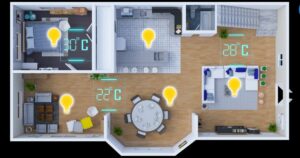What is sick building syndrome?
Sick building syndrome (SBS) is when the occupants of a building experience symptoms of illness or discomfort that seem to be related to the time they spend in the building. These symptoms may include headache, eye irritation, cough, and skin irritation. The cause of SBS is often difficult to identify, but often, it is thought to be related to the quality of the air inside the building and other environmental factors such as temperature and humidity. In some cases, SBS may be caused by the presence of mold or other indoor pollutants. These symptoms may dissipate upon leaving the building. If you think you may be experiencing SBS, it is important to speak with a healthcare provider for proper diagnosis and treatment.
What are common causes of sick building syndrome?
There are many potential causes of sick building syndrome (SBS), and the cause may be difficult to identify in most cases. However, some common causes of SBS include:
Poor indoor air quality: This can be caused by various factors, such as volatile organic compounds (VOCs) from paints and other building materials, air contaminants from outside the building, and poor ventilation.
Temperature and humidity: Extreme or fluctuating temperatures and humidity levels can cause discomfort and lead to SBS.
Poor lighting: Dim or poorly positioned lighting can cause eye strain and fatigue.
Noise: Excessive noise or poorly designed acoustics can be a source of stress and contribute to SBS.
Poorly maintained building systems: Malfunctioning heating, ventilation, and air conditioning (HVAC) systems can contribute to SBS. This is often the actual cause behind other poor air quality problems.
Lack of access to fresh air: Buildings that are not designed to allow fresh air circulation may have higher levels of indoor air pollution, which can contribute to SBS.
Biological contaminants: The presence of mold, bacteria or other biological contaminants in the air can cause or contribute to SBS.
It is important to note that SBS can have multiple causes; in some cases, more than one factor may contribute to the symptoms experienced by the occupants of a building.
What can I do about sick building syndrome?
The answer to this primarily depends on if you are the building manager or an occupant. While building managers often need to make the physical change, occupants can often bring awareness to the problem, as many building managers may be unaware if they are experiencing symptoms.
Identifying and raising awareness about the correct source of the problem: In some cases, the answer may be obvious, such as an odd odor or poor lighting. If the problem is not apparent, you can start by monitoring air quality through a device like Vertices AQS. Air quality monitors show elements that may affect SBS, such as carbon monoxide, carbon dioxide, VOCs, particulate matter, and more. If you’re a building occupant, IAQ monitors may also help raise awareness of an issue in the building and identify what it is.
Improve ventilation: If the source of SBS is unknown, it can often be mitigated by increasing ventilation if possible. For example, increasing the amount of fresh air inside the building should dilute an irritant causing SBS.
Disinfect and purify the air: Since so many possible causes have to do with indoor air quality and pollutants, disinfecting and purifying the air should treat many causes of SBS (note: it may not eliminate the source of the problem. More on that later). Find an air purifier that is proven and 3rd party tested, like the Air Guardian, to ensure the maximum treatment of air pollutants. A quality air purifier should meet CDC recommendations of UVGI and directional airflow. If you are a building occupant, you may be able to purchase an air purifier that treats your personal space.
Control moisture: Excess moisture can lead to mold growth and other indoor air quality problems. Ensure the building is insulated and ventilated to prevent moisture buildup.
Regular cleaning and maintenance: Keeping the building clean and well-maintained can help reduce indoor pollutants. When cleaning, use cleaners that are low on toxic chemicals and if these chemicals must be used, try to minimize their usage during peak building occupancy times.
Education and awareness: Provide education and awareness to all the people using the building on maintaining a healthy indoor environment and using any ventilation or purification equipment in their space. Make sure they know how to report potential issues to human resources or the building manager.
Hire Professional Inspection: To ensure that all the above steps are properly taken, hire a professional indoor air quality inspector to evaluate the building and make recommendations for improvement.
It is important to note that the approach will vary depending on the specific problem and the building, so it is essential to have a professional assessment before starting any work.






